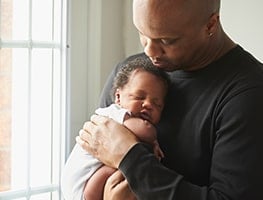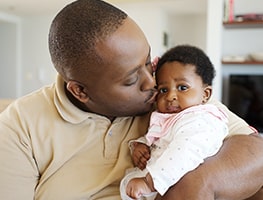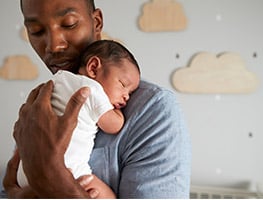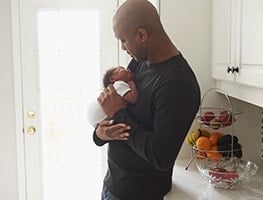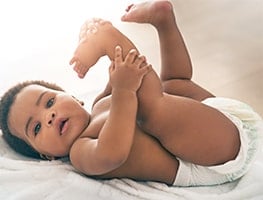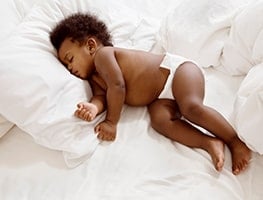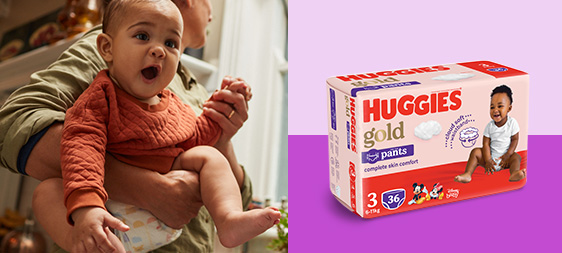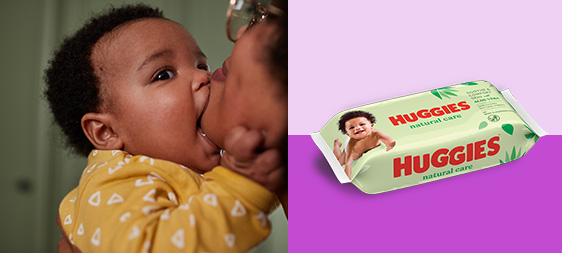One of the most exciting aspects of preparing for a new baby is organising their nursery. Thinking about where your baby will eventually sleep, and what they are going to sleep in, takes some planning and discussion. Practical factors, such as the size of your house and the number of children you have or want, will determine whether the new baby will have their own room, or will need to share with an older sibling. There is too much individual variation in families and homes to say what the best option is. Parents generally make their own decisions based on what will work in their home and what suits their own family.
No matter how much planning is done, most parents want their newborn to sleep in the same room as they do. The parent’s bedroom is actually recommended as the safest place for babies to sleep for the first 6-12 months of their life. Placing your baby’s cot or bassinette next to your bed, will allow you to see them and feel reassured they are safe. Parents and their newborns are not meant to be physically separated, and they need to be close to each other. After 12 months, most parents are ready to move their baby into their own room or nursery.
Cot or cradle – which is better?
This is really about personal choice. Some parents prefer the size of a cradle because it takes up such a small amount of space and is portable. Mothers, particularly, may feel that a bassinette creates a cosier sleeping atmosphere for their small baby. Other parents like to use a cot from birth and thus avoid the inevitable transition to one when the baby is around 3-4 months old.
The major considerations are the safety aspects of both. If a cot or bassinette has been handed down in a family, and has not been bought new, it needs to be checked as safe so it does not pose a risk of harm. If buying new, see that it has the SABS stamp of approval.
Bassinettes look sweet, though parents need to be careful about using bumpers, ribbon ties and lots of loose bedding in them. Those that have a rocking function can be risky, especially with young toddlers in the house. Bassinettes with wheels need to have a locking mechanism as well.
Swaddling
Swaddling or wrapping has always been a good way of calming young babies. It helps them to feel secure and contains their startle reflex. It also provides stability and encourages them to stay on their back while they are asleep. This is one of the protective measures against Sudden Infant Death Syndrome (SIDS). There are several different methods of wrapping and, as a baby gets older, they often like to have their hands and arms free. Wrapping from just the waist down can be effective for babies aged 3-6 months.
A light cotton or muslin wrap is ideal to use and can be washed and dried easily. Most parents find that they need a few wraps to ensure they have enough to keep rotating them through the laundry. In summer, it is often enough to dress a baby in just a singlet and nappy underneath a light fabric, open-weave wrap.
Some babies don’t like the feeling of being contained in a wrap and prefer not to be. Not all babies are happy to be wrapped and wriggle their way out, no matter how well you wrap them! Wrapping should not be something that you force onto your baby. Tucking your baby in and making sure there is no loose bedding they can slide under, is a safe option.
An alternative to wrapping is to use a sleeping bag. You will need to make sure you get one that is the right size for your baby and that has a fitted neck and armholes. These are particularly useful in winter and you can add layers of clothing underneath, depending on how cold it is.
Safe sleeping guidelines
Sleep your baby on their back from birth, not on their tummy or side.
Sleep your baby with their face uncovered. Don’t use duvets, pillows or soft toys in their cot.
Don’t let your baby near tobacco smoke before they are born, or afterwards.
Make sure your baby has a safe sleeping environment with a safe cot, safe mattress, and safe bedding.
Sleep your baby in their own safe sleeping environment next to your bed for the first 6 to 12 months of their life.
Co-sleeping or bed sharing
In many societies, parents co-sleep with their children. Co-sleeping is thought to help with bonding, successful breastfeeding, and to promote better sleep. Some experts believe co-sleeping is protective to children; and even when they’re asleep, parents retain a sense of surveillance over their child.
If you co-sleep, it is important that you never go to sleep with your baby lying on their tummy, on your chest. If parents choose to co-sleep, there are some important safety aspects they need to consider:
Babies are at great risk if they sleep on their tummies or their sides, and their face is covered by bedding.
Babies must not share their bed with other children or pets.
The following types of parents should not co-sleep with their babies: Parents who:
smoke
take medication that interferes with their sleep
have drunk alcohol
are obese
The bed needs to be firm and safe, with a firm-fitting mattress and no gaps where the child could fall through and be trapped. Waterbeds, sofas / couches, lounges, bean bags, pillows, duvets and quilts should not be used.
There is a risk of a child falling onto the floor from a bed or becoming trapped between its parents, particularly if they are overweight or heavy sleepers. Even pushing a bed up against a wall is not protective as babies can get trapped between the wall and the bed.
If you do choose to co-sleep, position your baby at the side of one parent, not in between you both.
Bedding
The major issues you should consider with bedding are - is it safe and is it clean?
Factors that are worth considering:
How practical and easy is it to wash bedding. Being able to throw sheets and blankets in the washing machine, and then line drying them, will save you a lot of time and energy. Avoid harsh detergents with strong perfumes; these can irritate a baby’s skin.
Try to have enough bedding so you do not have to wash constantly. Babies aren’t careful about where they spit up and don’t “hold on” until there is a nappy underneath them.
Aim for 100% cotton and natural materials where you can. Babies’ skin can easily be irritated by artificial fibres. Static electricity builds up in nylon blends, whereas cotton and linen blends feel better on their skin.
Avoid using pillows until your baby is in a bed. They are a safety risk for small babies, who can wedge their heads under them. Older babies can also use a pillow as a step to hoist themselves up and out of their cot.
Layering is the secret to warmth, rather than one heavy blanket. It is better to swaddle or wrap your baby, then tuck them in with a light-weight blanket over the top, rather than using one heavy duvet or blanket over them.
Aim to position your baby in the lower end of their cot rather than towards the top. Resting their feet on the bottom cot rails will stop them from sliding under the covers and their face getting covered.







